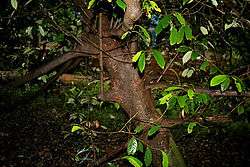Magnoliales
| Magnoliales | |
|---|---|
 | |
| a Magnolia flower, showing all the parts | |
| Scientific classification | |
| Kingdom: | Plantae |
| Clade: | Angiosperms |
| Clade: | Magnoliids |
| Order: | Magnoliales Juss. ex Bercht. & J.Presl[1] |
| Families | |
|
Annonaceae | |

The Magnoliales comprise an order of flowering plants.
Classification
The Magnoliales include six families:
- Annonaceae (custard apple family, over 2000 species of trees, shrubs, and lianas; mostly tropical but some temperate)
- Degeneriaceae (two species of trees found on Pacific islands)
- Eupomatiaceae (two species of trees and shrubs found in New Guinea and eastern Australia)
- Himantandraceae (two species of trees and shrubs, found in tropical areas in Southeast Asia and Australia)
- Magnoliaceae (about 225 species including magnolias and tulip trees)
- Myristicaceae (several hundred species including Nutmeg)
APG system
The APG system (1998), APG II system (2003), and APG III system (2009) place this order in the clade magnoliids, circumscribed as follows:[1]
order Magnoliales
|
| |||||||||||||||||||||||||||||||||||||||||||||||||||
| The current composition and phylogeny of the Magnoliales.[2][3] | ||||||||||||||||||||||||||||||||||||||||||||||||||||
In these systems, published by the APG, the Magnoliales are a basal group, excluded from the eudicots.
Earlier systems
The Cronquist system (1981) placed the order in the subclass Magnoliidae of class Magnoliopsida (=dicotyledons) and used this circumscription:
- order Magnoliales
- family Annonaceae
- family Austrobaileyaceae
- family Canellaceae
- family Degeneriaceae
- family Eupomatiaceae
- family Himantandraceae
- family Lactoridaceae
- family Magnoliaceae
- family Myristicaceae
- family Winteraceae
The Thorne system (1992) placed the order in superorder Magnolianae, subclass Magnoliidae (= dicotyledons), in the class Magnoliopsida (= angiosperms) and used this circumscription (including the plants placed in order Laurales and Piperales by other systems):
- order Magnoliales
- family Amborellaceae
- family Annonaceae
- family Aristolochiaceae
- family Austrobaileyaceae
- family Calycanthaceae
- family Canellaceae
- family Chloranthaceae
- family Degeneriaceae
- family Eupomatiaceae
- family Gomortegaceae
- family Hernandiaceae
- family Himantandraceae
- family Illiciaceae
- family Lactoridaceae
- family Lauraceae
- family Magnoliaceae
- family Monimiaceae
- family Myristicaceae
- family Piperaceae
- family Saururaceae
- family Schisandraceae
- family Trimeniaceae
- family Winteraceae
The Engler system, in its update of 1964, placed the order in subclassis Archychlamydeae in class Dicotyledoneae (=dicotyledons) and used this circumscription:
- order Magnoliales
- family Amborellaceae
- family Annonaceae
- family Austrobaileyaceae
- family Calycanthaceae
- family Canellaceae
- family Cercidiphyllaceae
- family Degeneriaceae
- family Eupomatiaceae
- family Eupteleaceae
- family Gomortegaceae
- family Hernandiaceae
- family Himantandraceae
- family Illiciaceae
- family Lauraceae
- family Magnoliaceae
- family Monimiaceae
- family Myristicaceae
- family Schisandraceae
- family Trimeniaceae
- family Tetracentraceae
- family Trochodendraceae
- family Winteraceae
The Wettstein system, latest version published in 1935, did not use this name although it had an order with a similar circumscription with the name Polycarpicae. This was placed in the Dialypetalae in subclass Choripetalae of class Dicotyledones. (See also Sympetalae).
From the above it will be clear that the plants included in this order by APG have always been seen as related. They have always been placed in the order Magnoliales (or a predecessor). The difference is that earlier systems have also included other plants, which have been moved to neighbouring orders (in the magnoliids) by APG.
References
| Wikimedia Commons has media related to Magnoliales. |
| Wikispecies has information related to: Magnoliales |
- 1 2 Angiosperm Phylogeny Group (2009). "An update of the Angiosperm Phylogeny Group classification for the orders and families of flowering plants: APG III" (PDF). Botanical Journal of the Linnean Society. 161 (2): 105–121. doi:10.1111/j.1095-8339.2009.00996.x. Retrieved 2013-07-06.
- ↑ Angiosperm Phylogeny Group (2003). "An update of the Angiosperm Phylogeny Group classification for the orders and families of flowering plants: APG II". Botanical Journal of the Linnean Society. 141 (4): 399–436. doi:10.1046/j.1095-8339.2003.t01-1-00158.x.
- ↑ Soltis, P. S.; D. E. Soltis (2004). "The origin and diversification of Angiosperms". American Journal of Botany. 91 (10): 1614–1626. PMID 21652312. doi:10.3732/ajb.91.10.1614.